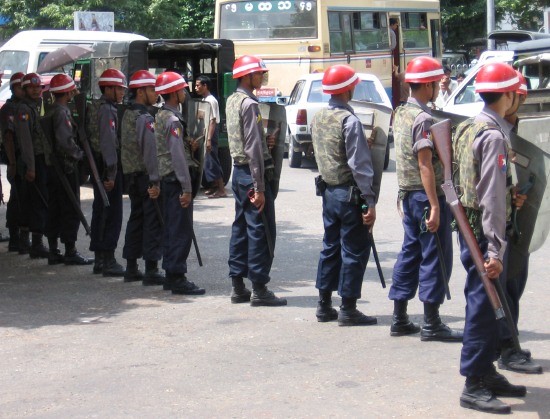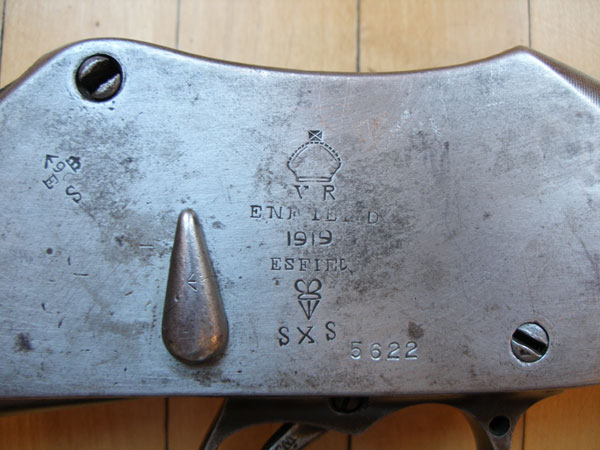 |
|
1) Where can I buy a Martini-Henry? Without a doubt, the number one question I hear. Martinis have become somewhat scarce in the past few years. When I started actively purchasing Martinis about three years ago, a Martini-Henry (.450 Martini-Henry Caliber) could be had for about US$500, and Martini-Enfields (.303 British Caliber) were in the $275 range. Since then, those prices have doubled. If you want a British Service Rifle, don't shop for one in the US, shop for one in places they were actually used. Australia and New Zealand seem to be the best places to find them. For the most part, the supply has dried up in England. At one time, Martinis were common as cordwood down under, but us greedy Americans have nearly bought up the supply. Still, an occasional deal can be found down under. Check out my links page for dealers who sell Martinis. Another place to look is on gun auction sites, like gunbroker.com or gunsamerica.com. Be prepared for very high prices though. The rarity of these weapons is really driving the prices up on auction sites, and bidding wars are quite common for even the most mediocre Martini specimens. |
|
2) Where can I buy a reproduction Martini-Henry? The answer to this one is simple...you can't. At the current moment, nobody in the world offers a reproduction Martini-Henry for sale. Sure, companies like 2nd Amendment Research offer "refurbished" Martinis, but that's not new in my book. The way to change this is to contact the two big manufacturers of reproduction antique weapons...Uberti and Pedersoli. You should only do this if you're legitimately interested, and committed to buying a reproduction Martini-Henry. Don't "stuff the ballot box" with false bravado, simply to get them to produce a weapon that only a handful of people will buy. The last thing we want to do is financially hurt companies like these with such a venture. Uberti and Pedersoli are our friends! On the other hand, do we really need or want them to make another lever-action reproduction cowboy gun instead of a M-H? Uberti's email address is: mail@uberti.com. Pedersoli's address is: pedersol@lumetel.it. Be polite, and explain that there is interest in such a weapon, and that you would purchase one (or more) if they ever decided to make one. |
|
3) Where can I get .450 Martini-Henry ammo? "I just bought a Martini-Henry and would like to shoot it...where can I get ammo?". This is another common question I get. Let me first begin by saying that commercial production of .450 Martini-Henry ceased many, many years ago, so it's not something you'll be able to walk into your local sporting goods store and buy off the shelf. Recent attempts by companies to reproduce the .450 M-H have been (in my humble opinion) dismal failures. Prices were far too high, and the quality simply was not there. So...Handloading your own is really the only way to go if you plan on shooting your Martini-Henry often, or desire any modicum of accuracy. Brass is available at a reasonable price from a few places. Check the links page for details. Also, over on the martiniforum.org forum, the group periodically gets together, and makes large purchases of Jamison Brass, en masse (in order to get a significant discount). Lee makes an AWESOME set of reloading dies for the .450 Martini-Henry, at a VERY REASONABLE price. Sometimes ammo and brass can be found on auction sites, or through antique dealers...please do not shoot antique ammo! It's worth more as an antique, and can be dangerous to you and your Martini. |
|
4) Can I safely shoot over-the-counter .303 ammo in my Martini-Enfield? You've made a wise choice in purchasing a Martini-Enfield in .303 British. Though worth less than a Martini in the original .450 Martini-Henry caliber, Martini-Enfields make fine shooters. These weapons will handle standard, over-the-counter, commercially produced, modern .303 ammunition. This is stuff you can walk into your nearest sporting goods store and buy. Martini-Metfords do not handle modern ammo so well. Since the Metford rifling was designed for use with black powder only, rapid bore erosion will occur if modern smokeless powder cartridges are used in Martini-Metfords. As with any antique weapon, please have it certified safe to fire by a competent gunsmith before attempting to shoot it. |
|
5) What can you tell me about Greener Martini Police Shotguns and their special cartridges? After W.W.I, the Egyptian Government sought a weapon suitable for arming their police force. W.W. Greener of Birmingham won the contract with their submission of a handy, smoothbore Martini actioned shotgun with a full length wood forend. These shotguns were known as the Greener Mark I/14. The "14" referred to the bore size. One of the clever features of the new shotgun was that it used an off size 14 1/2 gauge straight sided shot shell. This prevented the weapon's use with commercially available shotgun shells. Thus, if the weapon fell into the wrong hands, it couldn't be used against the Egyptian Police. Greener referred to this cartridge as "14 bore for use in Mark I guns". These cartridges were made by Kynoch. Most were loaded with smokeless powder, but some have been noted with black powder loads. By 1922, over 30,000 Greeners had been supplied to the Egyptian Government. In the 1930s, it was discovered that stolen Mark Is were being used against the authorities by wrapping a thick piece of paper around standard 16 gauge shot shells in order to beef them up to 14 1/2 gauge! Greener answered this problem with the Greener Police Gun Mark III, Patent Number 463628/35. The Mark III could be ordered in three different chamberings: the original 14 1/2 gauge Mark I shells, standard 12 gauge 2 3/4" shells and a special bottlenecked shell for the Egyptians. The Mark III bottle necked shell was .782" diameter at the base, and was necked down to .740". Overall length of the shell was 2 7/8". The new bottlenecked form of the cartridge was enough to prevent the weapon's unauthorized use by the bad guys, but Greener went a step further by adding a large annular groove in the base of the shell. When a shell is chambered, two lugs protrude from the face of the breechblock and engage the annular groove in the base of the shell. This meant that the gun could only be fired if the correct, grooved shells were used. Kynoch and Service Armament Co. made shells for the Mark III Special into the 1960s. Mark III Specials are commonly seen for sale in the US$150 neighborhood.
Burmese Police using Greener Police Gun Mark III/12 shotguns in September, 2007 Photo: Miles Vining |
|
6) What can you tell me about the customized Martini I bought in Afghanistan-Pakistan-Saudi Arabia, etc? "Arabicized" Martinis, or those owned and customized by Arab civilians are rather common. Most of these started life as British Trade-Pattern Martinis, or Khyber Pass copies. Many owners would then embellish them with gold or silver inlays, guilding, wire-wrappings, brass tacks, carvings and other ethnic beautifications. Examples range in quality of workmanship and appearance from beautiful works of art to downright gaudy. Determining manufacturer is often impossible. Only in cases where the original maker's marks remains will positive ID be an easy task. These weapons tend to have little to no value to the Martini-Henry collectors I've discussed them with, but collectors of Arabian items may find them of interest. 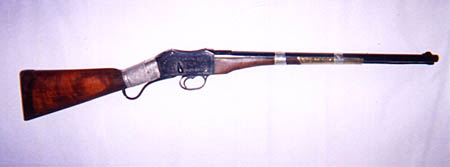 |
|
7) I bought a Martini, and I notice the "N" in "Enfield" is backwards. Why is this? OR... I'm stationed in Afghanistan, and just bought a Martini-Henry. Can you tell me what I've got? Your weapon was not made in England, but rather by the local artisans in Afghanistan. You have what is commonly referred to as a "Khyber Pass Copy". The Khyber Pass is a 33 mile route through the Hindu Kush mountain range. It connects the northern frontier of Pakistan with Afghanistan. The local craftsmen there are well known for making "knock-off", or reproduction firearms (including AK-47s nowadays as I understand). One of the oddities of Khyber Pass Martinis is that they even tried to copy the stampings and markings from their original source Martini. Backwards letters and misspellings are common. The majority of Khyber Pass Martinis I've seen have typos that are very similar. One of the most common is to have the "N" in "Enfield" backwards...likely because one "Master Copy" of an original Martini was made, then passed around for others to makes copies from. The erroneous marking was then faithfully copied from one weapon to the next. The 1901 date, though wrong for a Mark II, is correct, in that it was when the Khyber Pass artisans made the rifle pictured below. Reproduction Martinis were made in the Khyber Pass probably into the late 1940s!!! As with other "Arabicized" Martinis (see above), they're not terribly prized as collector's pieces, and they're of mediocre quality at best. In fact, the widespread belief is that the steel for producing these weapons is said to have come from stolen lengths of railroad track! Eventhough many of these rifles are still in very nice condition, I personally wouldn't shoot one. 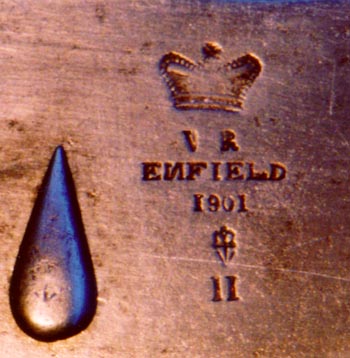
|
|
8) How can I tell if my .303 Caliber Martini has Enfield or Metford Rifling? There are two quick ways to determine the type of rifling your .303 Martini has based on its markings. The first is to look for the letter "E" stamped into the top of the nocksform. In the picture below, you can tell this Martini features Enfield Rifling by the large "E". 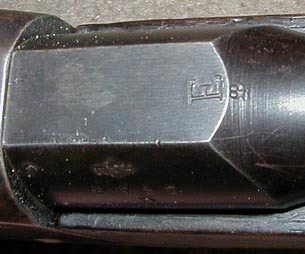 The second quick way to determine which rifling your .303 Martini has is to check the Conversion Cypher on the left side of the action body. This will usually read "M.M." for conversion to a "Martini-Metford", or "M.E." for "Martini-Enfield". 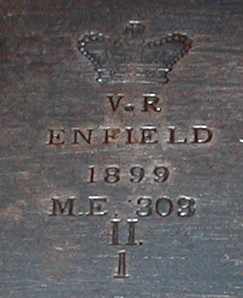 If you have a trade pattern rifle, or one without the traditional service markings, you'll have to examine the bore visually to try and make the determination. Refer to the image below for comparison purposes. 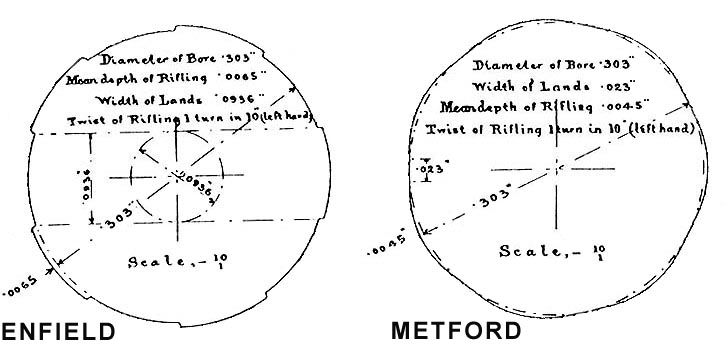
|
|
9) Where can I find my Martini's serial number? The serial number for military Martinis consisted of a maximum of four numbers, prefixed by one or two letters. An example of a valid Martini-Henry serial number would be: D2657, as can be seen on the example below. On large frame military Martinis, it can be found on the front of the action body (concealed by the forend wood), on the barrel and on the rear sight leaf (sometimes the number only on the rear sight leaf). Some manufacturers did not include a prefix letter on early runs of production, so it's possible to see weapons without a letter prefix. It is also possible to see two Martinis with the same number from two different manufacturers. 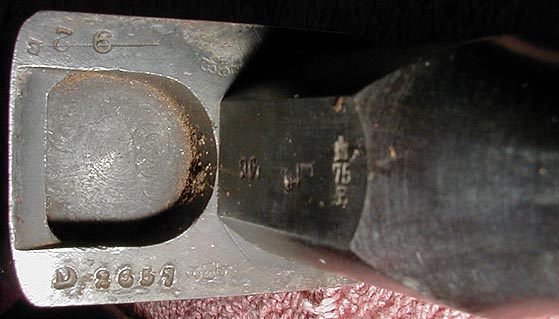
|
|
10) Where can I find Machinist Drawings of the Martini-Henry? Ian Skennerton is currently selling full size, retouched armorer's drawings for US$30 plus shipping. These can be ordered here... |
|
11) Where can I buy a sling for my Martini-Henry? |
|
|
|
Martini Home | The Boxer-Henry Cartridge | Carbines | Infantry Rifles | Zulu War | Markings | Bayonets | Links
|
|
|
|
|
|
|
|
|
|
|
|
|
|
|
|
|
|
|
|
|
|
|
|
|
|
|
|
|
|
|
|
|
|
|
|
|
|
|
|
|
|
|
|
|
|
|
|
|
|
|
|
|
